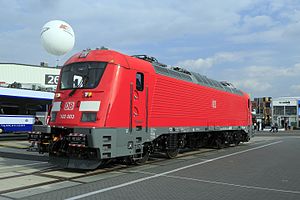DB class 102
| DB series 102 Škoda type 109 E3 |
|
|---|---|
|
102 003 at InnoTrans in Berlin (September 2016)
|
|
| Numbering: | 102 001 - 006 |
| Number: | 6th |
| Manufacturer: | Škoda Transportation , Pilsen |
| Year of construction (s): | 2016 |
| Axis formula : | Bo'Bo ' |
| Gauge : | 1435 mm ( standard gauge ) |
| Length over buffers: | 18,000 mm |
| Height: | 4275 mm |
| Width: | 3080 mm |
| Trunnion Distance: | 8,700 mm |
| Bogie axle base: | 2,500 mm |
| Total wheelbase: | 11,200 mm |
| Smallest bef. Radius: | 120 m |
| Service mass: | 88 t |
| Top speed: | 200 km / h |
| Continuous output : | 6400 kW |
| Starting tractive effort: | 275 kN |
| Continuous tensile force: | 220 kN |
| Driving wheel diameter: | 1250 mm |
| Motor type: | ML 4550 K / 6 |
| Power system : | 15 kV / 16.7 Hz ~ |
| Power transmission: | Overhead line |
| Number of traction motors: | 4th |
| Drive: | Hollow shaft drive with three-phase asynchronous motors |
| Brake: | electrical resistance brake , (continuous output 4,700 kW) electrical mains brake , continuous output (6,963 kW) |
| Train control : |
PZB LZB 80E |
The vehicles of the DB series 102 are electric locomotives from DB Regio for high-speed traffic , which correspond to the type 109 E from the Czech manufacturer Škoda Transportation . The six ordered locomotives are intended for the Munich-Nuremberg Express , where they should be used from December 2017 together with newly built double-decker push-pull trains.
history
After winning the Ringzug West / NBS tender , DB Regio Oberbayern ordered 6 Škoda 109 E3 locomotives from Škoda for use in the Munich-Nuremberg Express for use from December 2016. The locomotives were given the DB class designation 102. In contrast For the sister series, the DB did not order a multi-system version, but only locomotives for the 15 kV alternating current common in Germany. With six Škoda push-pull double-decker cars each, the locomotives are to provide high-speed regional traffic with a top speed of 200 km / h on the high-speed line Nuremberg – Ingolstadt – Munich . DB Regio Oberbayern only asked for approval for 189 km / h. The order for the six train sets is worth 100 million euros.
At the end of April 2016, the first completed locomotive 102 001 was transferred to the Velim railway test ring . Škoda began testing the first two locomotives for EBA approval of the series in Velim in the second quarter of 2016.
The locomotive 102 003 was presented together with other Škoda products at the InnoTrans in Berlin from September 20 to 25, 2016 .
In July 2017, test drives took place with the complete trains on the high-speed line Mannheim – Stuttgart. At the beginning of November 2018, the combination of locomotive and wagon train for the Munich-Nuremberg Express received TSI certification for high-speed trains, but not yet the final approval, which Škoda was hoping for "early 2019". In November 2018 there was a report on the receipt of TSI certification for the 102 series and the double-decker cars.
Another delay in the approval of the trains was reported in May 2019. In June 2019, the BEG announced a preliminary operation between Munich and Ingolstadt until December 2019. However, this did not take place. Due to the lack of approval, operation in the 2020 annual timetable will still be with the previous vehicles. In April 2020 it became known that the use of the trains would be delayed further and indefinitely, as DB Regio refused to accept the manufacturer.
technical features
The locomotives differ from the ČD 380 in some details (e.g. driver's cabs) .
Web links
Individual evidence
- ↑ a b c d e f g h i j Modern push-pull trains. (PDF; 1.51 MB) On the regional high-speed line Nuremberg – Ingolstadt – Munich. Škoda Transportation, DB Regio AG, September 12, 2014, accessed on February 21, 2015 .
- ↑ http://www.skoda.cz/de/press/zum-downloaden/neuer-katalog-fahrzeuge-deutschland/Contents.2/0/66E3341EBFAA9DBC85EA8B064122BF44/resource.pdf
- ↑ DB Regio orders Škoda trainsets for fast regional services. June 18, 2013, accessed June 18, 2013 .
- ↑ DB Regio Oberbayern is pleased to have won the Ringzug West / NBS tender. Deutsche Bahn, June 17, 2013, accessed June 18, 2013 .
- ↑ High-speed locomotives from Škoda will be running in Bavaria from 2016. Škoda Transportation, June 18, 2013, archived from the original on March 3, 2015 ; Retrieved June 18, 2013 .
- ^ DB 102 in Velim . In: Eisenbahn-Revue International . No. 6 , 2016, p. 289 .
- ↑ http://ekonomika.idnes.cz/skoda-ukazala-prvni-lokomotivu-pro-deutsche-bahn-f70-/eko-doprava.aspx?c=A160627_140031_eko-doprava_kris , June 27, 2016, accessed on September 13 2016.
- ↑ Test drives with the Skoda double-decker train . In: Eisenbahn Magazin . No. 9 , 2017, p. 29 .
- ↑ https://www.eurailpress.de/nachrichten/fahrzeuge-verbindungen/detail/news/muenchen-nuernberg-express-skoda-bekommen-tsi-zertifikation-fuer-mne-zuege.html
- ^ Munich-Nuremberg Express: Škoda receives TSI certification for MNE trains. Retrieved December 8, 2019 .
- ^ Eisenbahn-Kurier - Prototype and model - Skoda: TSI certification for Munich-Nuremberg Express. Retrieved December 8, 2019 .
- ↑ Munich-Nuremberg Express remains the fastest regional transport in Germany. Retrieved December 8, 2019 .
- ^ Eisenbahn-Kurier - Prototype and model - Munich-Nuremberg Express: approval of Skoda trains is still delayed. Retrieved December 8, 2019 .
- ↑ Munich-Nuremberg Express continues to be the fastest regional service in Germany. Retrieved December 8, 2019 .
- ^ Munich-Nuremberg express with old material . In: Bahn-Report . No. 1 , 2020, ISSN 0178-4528 , p. 18 .
- ↑ Record delay: Deutsche Bahn does not want to accept new trains. Retrieved April 22, 2020 .
- ↑ http://www.zelpage.cz/zpravy/9634?lang=de Škoda představila lokomotivy řady 102 per DB Regio from June 29, 2016, accessed on September 19, 2016.

